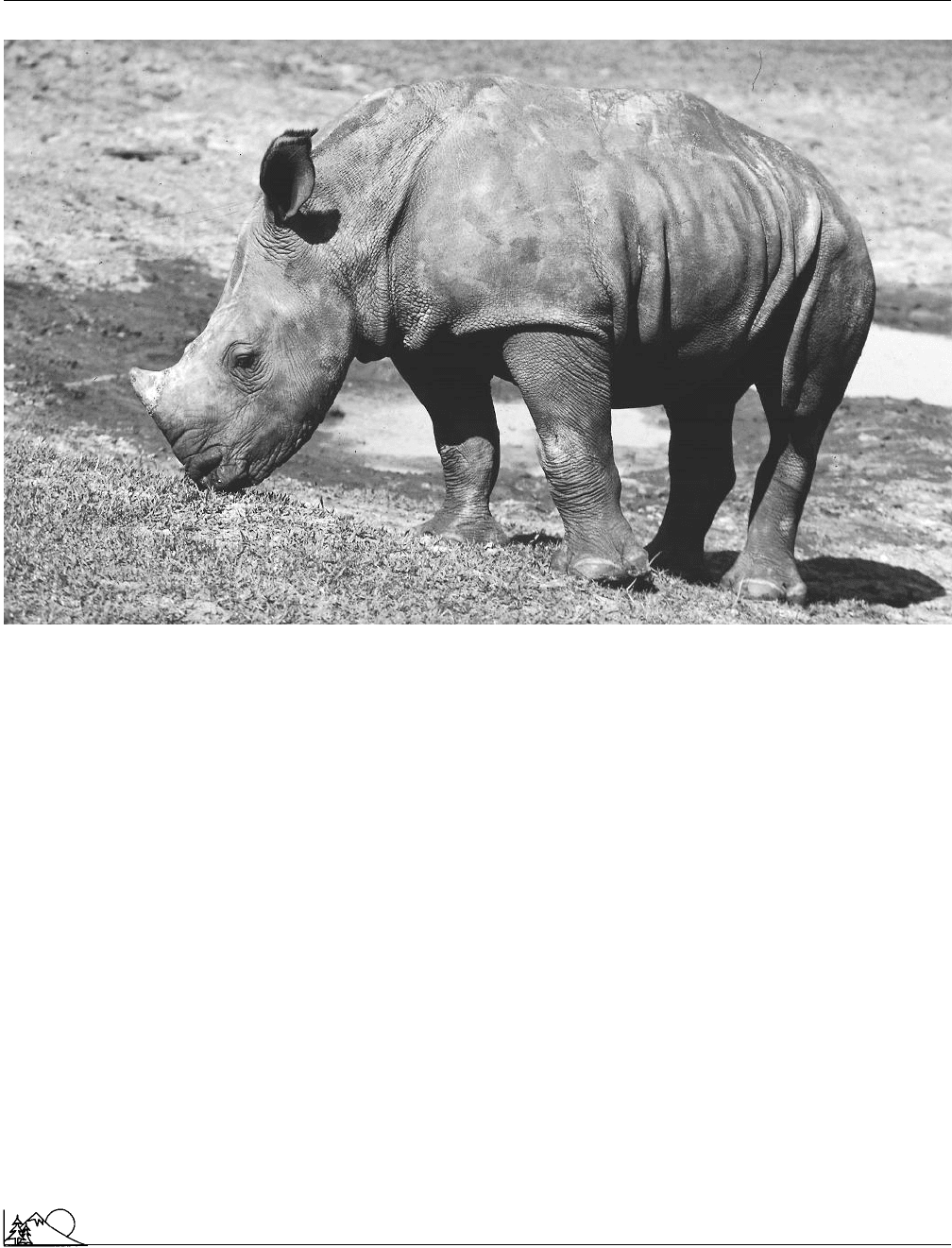Environmental Encyclopedia
Подождите немного. Документ загружается.


Environmental Encyclopedia 3
Ribonucleic acid
Great Indian rhinoceros. (Photograph by Gerald Davis. Phototake. Reproduced by permission.)
The smaller two-horned black rhinoceros (Diceros bi-
cornis) has a pointed upper lip for feeding on leaves and twigs.
Black rhinos can be aggressive but their poor eyesight makes
for blundering charges. Black rhinos (which are actually dark
brown) were once common throughout sub-Saharan Africa
but are now found only in Kenya, Zimbabwe, Namibia, and
South Africa. Today, there are only 2,600 black rhinos left in
the wild, compared to 100,000 30 years ago.
Widespread
poaching
has diminished rhino popula-
tions. The animals are slaughtered for their horns, which are
made of hardened, compressed hair-like fibers. In Asia, the
horn is prized for its supposed medicinal properties, and pow-
dered horn brings $28,000 per kg. In Yemen, a dagger handle
made of rhino horn can command more than $1,000. As a
result, rhinos now survive only where there is strict protection
from poachers. Captive breeding programs for endangered
rhinos are hindered by the general lack of breeding success for
most species in zoos and a painfully slow reproduction rate of
only one calf every three to five years. The present world rhino
population of about 16,000 is little more than half the esti-
mated “safe” long-term survival number of 22,500.
[Neil Cumberlidge Ph.D.]
1207
R
ESOURCES
B
OOKS
Cumming, D. H. M., R. F. Du Toit, and S. N. Stuart. African Elephants
and Rhinos: Status Survey and Conservation Action Plan. Gland, Switzerland:
IUCN-The World Conservation Union, 1990.
Penny, M. Rhinos, Endangered Species. New York: Facts on File, 1988.
P
ERIODICALS
“Southern White Rhino comes back after Its Brush with Extinction.”
Winston-Salem Journal, January 23, 2000, D6.
Tudge, C. “Time to Save the Rhinoceroses.” New Scientist 28 (September
1991): 30–5.
O
THER
Save the Rhino. [cited May 2002]. <http://www.savetherhino.org/index>.
Ribonucleic acid
Ribonucleic
acid
(RNA) exists as a polymer constructed of
four kinds of nucleotides. Ribonucleic acids are ordinarily
involved in the conversion of genetic information from DNA
into protein: information flows from the genetic material
via RNA for the fabrication of an organism. Ribosomes are

Environmental Encyclopedia 3
Ellen Henrietta Swallow Richards
cytoplasmic particles structured of protein and ribosomal
RNA (rRNA) and are the sites of protein synthesis. Messen-
ger RNA (mRNA), transcribed from genomic DNA, trans-
locates genetic information to the ribosomes. In addition,
there are about 20 transfer RNAs (tRNA), which bind to
specific amino acids and to particular regions of mRNA
for the assembly of amino acids into proteins. The genetic
material of some viruses is RNA.
Ellen Henrietta Swallow Richards
(1842 – 1911)
American chemist
Ellen Swallow Richards was born in Ipswich, Massachusetts,
and was a daughter of Peter and Fanny Swallow, who were
school-teachers and part-time farmers. Ellen Swallow ob-
tained a Baccalaureate (the equivalent of an undergraduate
degree) from Vassar Female College, and in 1870 she became
the first woman to be accepted as a student by the Massachu-
setts Institute of Technology (M.I.T.). Founded in Boston
in 1865, MIT had rapidly become a highly regarded school
of engineering and applied science. In 1873, she graduated
as a Bachelor of Science in chemistry and in the same year
received a Master of Arts degree from Vassar, based on a
thesis involving examination of the vanadium content of an
iron ore.
Ellen Swallow then spent several years studying to-
wards a doctorate at MIT, but did not graduate, apparently
because the faculty members of the department in which
she was studying, all of whom were men, were unwilling to
allow a woman to be the first-ever Doctor of Science gradu-
ate from their program. Ellen Swallow was undaunted by
this and other forms of gender bias that were pervasive at the
time. She went on to become a pioneer in the development of
the new engineering field of public
sanitation
, and was a
strong advocate of domestic science and home economics.
In 1875 Ellen Swallow married Robert Hallowell
Richards, a professor of metallurgy and mining engineering
at M.I.T. The couple shared a devotion to science and to
each other, but had no children. Ellen Richards collaborated
with her husband in his metallurgical and mining work, and
her contributions in those fields were recognized later on,
when she became the first woman to be elected to the Ameri-
can Institute of Mining and Metallurgical Engineers.
Ellen Richards understood that one of her major re-
sponsibilities was to foster the scientific education of Ameri-
can women. She was central in the establishment of a Wom-
en’s Laboratory at M.I.T., as well as other facilities and
programs that made important contributions towards
allowing women to pursue careers in science. Some of her
early research involved investigations of household and food
1208
chemistry and
food additives
. In 1882, she published The
Chemistry of Cooking and Cleaning, and in 1885 Food Materi-
als and Their Adulterations.
In 1884, Ellen Richards was appointed to a position
in a new chemical laboratory at M.I.T. that specialized in
the study of public sanitation. She held this position for 27
years until her death in 1911. One of her initial accomplish-
ments was running the chemical laboratory responsible for
the first survey of lakes and rivers in Massachusetts, an
extensive study that became a classic in its field.
In 1890, M.I.T. established a ground-breaking pro-
gram in sanitary engineering in which Ellen Richards taught
the chemistry and analyses of water, sewage, and
atmo-
sphere
. In collaboration with A. G. Woodman, in 1900
she published Air, Water, and Food Chemistry for Colleges,a
textbook in support of the teaching of public sanitation. Her
most important scientific contributions were in the field of
water sanitation. She was, for example, an influential advo-
cate of the
chlorination
of drinking water to kill pathogenic
bacteria. This practice was critical in lowering the high death
rates that were being caused by drinking unsanitary water
in most towns and cities of the time.
After about 1890, Ellen Richard’s interests increas-
ingly focused on what was to become known as the “home
economics movement.” This involved the study and teaching
of nutrition, food preparation, household sanitation and hy-
giene, and related subjects, mostly in the public school sys-
tem. The home economics movement can be likened to a
domestic-science literacy program for the masses, and it
became an important means by which urban women learned
how to run economical and healthy households. Ellen Rich-
ards wrote numerous papers and several books in this subject
area, including Home Sanitation: A Manual for Housekeepers
in 1887, Domestic Economy as a Factor in Public Education
in 1889, and Euthenics: The Science of Controllable Environ-
ments in 1912. Today Ellen Richards is considered a parent
of home economics in the United States. For this contribu-
tion, she is indirectly responsible for many pervasive im-
provements in living conditions throughout America and in
other countries where home economics has become a popular
subject in school curricula.
[Bill Freedman Ph.D.]
R
ESOURCES
B
OOKS
James, E. T., J. W. James, and P. S. Boyer, eds. Notable American Women.
1607–1950. Cambridge, MA: Belknap Press, 1971.
Stern, M. B. “The First Woman Graduate of M.I.T.—Ellen H. Richards,
Chemist.” In We the Women: Career Firsts of Nineteenth Century America.
New York: Schulte Pub. Co., 1962.

Environmental Encyclopedia 3
Right-to-act legislation
Right-to-act legislation
On September 3, 1991, 25 men and women perished in a fire
in a chicken-processing plant in Hamlet, North Carolina.
Workers were trapped inside the burning building because
managers of the plant had illegally bolted emergency exits
in order to prevent possible theft of chickens. The American
public reacted with outrage to news of the fire because it
was recognized that the employees’ deaths could have been
prevented if
Occupational Safety and Health Administra-
tion
(OSHA) standards regarding access to fire exits had
been enforced. As a result, labor representatives have repeat-
edly called for new, more effective means for protecting
Americans from the hazards of injury, illness, and death at
their workplaces.
In North Carolina, the site of the 1991 poultry plant
fire, Worker Right to Act (RTA) legislation has been en-
acted in an effort to meet those demands, and such legislation
is being proposed in other states. RTA legislation is designed
to give workers some of the power they need to avoid or
prevent exposure to such workplace hazards as those leading
to the poultry plant fire and those associated with use of
toxic
chemicals
. It is important to note that the goals of
RTA legislation overlap with those of
Toxics Use Reduc-
tion legislation
(TUR). TUR laws, which have been enacted
in at least 26 states, require business facilities to reduce their
use of toxic substances, thus protecting workers and other
community residents.
Although North Carolina has adopted a number of
RTA provisions through a series of separate statutes instead
of in a comprehensive, single package, RTA laws are only
in the proposal stage in most states in which they are being
advocated. In New Jersey, an initial four-year campaign for
adoption of Worker and Community RTA was unsuccessful.
Advocates of RTA in that state were optimistic that future
efforts will be successful and that their experiences would
benefit groups and individuals working for the enactment
of RTA laws in other states. Several years later, Passaic
County in New Jersey passed the nation’s first right-to-act
law in the spring of 1999. The measure allows 25 or more
neighbors and/or workers to petition the county Health
Officer for creation of a Neighborhood Hazard Prevention
Advisory Committee to monitor a specific facility. In addi-
tion, such committees have the authority to conduct walk-
through surveys of the plant, accompanied by technical ex-
perts. If a company refuses to cooperate, the county can sue
on behalf of the committee.
In Michigan, a comprehensive RTA bill was first con-
sidered in 1993 and has been reintroduced before the state
legislature several times since then. Therefore, the bill pro-
posed in Michigan is used here to illustrate the provisions
of a comprehensive RTA statute. Second, some of North
1209
Carolina’s RTA provisions are described to provide further
examples of RTA mechanisms.
Michigan’s proposed RTA law
A Worker RTA bill considered in Michigan in 1993
includes five sets of RTA protections. First, the bill mandates
that worker-management committees be established at each
worksite where the number of employees regularly exceeds
ten. If there is a government-certified labor organization at
the worksite, it will select the workers’ representatives. If
there is no certified labor organization, nonsupervisory em-
ployees will select their own representatives. The committee
must: (1) inspect the site at least monthly for existing or
potential safety, health, and environmental problems; (2)
investigate accidents and exposures that have the potential
to harm employees and the
environment
; and (3) conduct
annual reviews. The committee’s duties are cross-referenced
to a proposed Toxics Use Reduction and Community Right
to Act (TUR/CRTA) bill.
Second, the Michigan Worker RTA bill mandates
that each employer develop and implement a worksite safety
and health plan. Such plans must provide for periodic inspec-
tions of the worksite and require documentation of hazards
and actions taken to correct them.
Third, there are provisions giving any employee or
employee representative the right to request an inspection
by the Michigan Department of Labor or the Michigan
Department of Health if he or she believes that there is a
violation of a standard and that that violation threatens
physical harm to an employee. Before a representative of
one of those agencies makes a determination as to imminent
danger, an employee may choose not to perform an assigned
task if the employee has a reasonable apprehension of death
or serious injury and he or she reasonably believes that no
less drastic alternative is available.
Fourth, the Michigan bill increases the authority of
state inspectors regarding citations and penalties and autho-
rizes employees to contest the failure of such inspectors to
conduct inspections and issue citations. There are substantial
penalties for willful or repeated violations of the Act. Fifth,
an employer cannot
discharge
an employee or in any way
discriminate against an employee or job applicant because
he or she has filed a complaint under the Act or testified at
a proceeding under the Act.
It is significant that the Michigan TUR bill, entitled
the “Toxic Use Reduction and Community Right to Act Bill”
(TUR/CRTR), also includes RTA provisions. A summary of
some provisions of Michigan’s TUR/CRTA bill illustrates
the interrelationship between RTA and TUR laws. First,
TUR/CRTA establishes a goal of a 50% reduction in toxics
use and toxics waste generation over a period of five years, thus
reducing workers’ exposure to toxics. Second, companies and
governmental bodies that must report information under the

Environmental Encyclopedia 3
Right-to-act legislation
federal Emergency Planning and Community Right to Know
Act (EPCRA) must conduct audits of toxics used and gener-
ated as waste, and they must prepare plans and set goals for
reducing the amounts of those toxics at their facilities. Then,
annual reports must be filed, documenting progress in reach-
ing those goals. Third, communities are granted rights to
monitor business facilities through “community environmen-
tal committees.”This provision is cross-referenced to workers’
rights to investigate hazards under the Worker RTA bill.
Also, workers, through their committees established under
Worker RTA, have the opportunity to review and provide
inputon the facility’s TUR planbefore it is completed.Fourth,
there are provisions giving workers and community members
the right to take companies to court to compel them to comply
with the TUR/CRTA law.
North Carolina’s RTA statutes
North Carolina’s RTA statutes include some of the
same kinds of mechanisms in Michigan’s Worker RTA bill,
but, overall, they are not as comprehensive. For example,
North Carolina requires workplace safety committees and
the establishment of health and safety programs, but those
requirements are imposed only on employers of 11 or more
employees if those employers have a poor “experience rating”
under workers’ compensation laws. (A “1.5” rating or worse
is the measure used.)
North Carolina’s RTA statutes do include several pro-
visions which are not in the Michigan bill. North Carolina
has created a special emphasis inspection program to target
employers with high rates of violations or high rates of
illness, injury or death. Also, an interagency task force has
been created to study and issue a report setting out a plan
for reorganization of the occupational health and safety and
fire safety networks within North Carolina.
Significance of RTA laws
Labor leaders and workers in Michigan and in other
states continue to advocate adoption of RTA and are opti-
mistic that it will be adopted as leaders and citizens become
aware of the need for it and its benefits. RTA laws are
designed to lead to better enforcement of existing OSHA
standards. Under RTA, worker-management committees
conduct inspections of a workplace on a regular basis instead
of waiting for OSHA or its state counterpart to do so. Thus,
management and workers, as a team, become the primary
watchdogs for the work facility. A major reason for the lack
of enforcement by OSHA and its state counterparts is their
lack of funding for inspectors. Use of worker-management
committees provides a means of protecting workers despite
scarce government resources.
By mandating that employers prepare worksite safety
and health plans and that employee representatives be in-
cluded in that planning process, RTA laws are designed to
prompt employers and their employees to take a proactive
1210
stance with respect to workplace hazards. Workers are in-
cluded in planning because they are on the job on a day-
to-day basis and are in a good position to identify hazards
and recommend safer ways of working.
An important feature of RTA laws is that protections
are extended to non-unionized as well as unionized workers.
This is significant in view of figures showing that as of 1993
union membership in the United States had shrunk to a
five-decade low—16% of the work force.
Worker RTA also recognizes that even workers who
know about on-the-job hazards often lack viable alternatives
for safer ways to earn a living and support their families.
RTA provides the worker with mechanisms for reporting
hazards as well as the right to refuse to perform an assigned
task because of a reasonable apprehension of death or serious
injury. Also, anti-discrimination provisions encourage work-
ers to exercise their rights under the RTA law.
Finally, the interrelationships between the goals and
provisions of RTA and TUR statutes and the fact that such
laws are being supported by a coalition of labor interests
and environmentalists appear to signal a shift in public policy
in this country. For decades, United States laws have divided
laws on health and safety regulatory authority according
to site: OSHA in the workplace and the
Environmental
Protection Agency
(EPA) outside the workplace. Also, ex-
isting laws have mandated different approaches to regulation
of different media pursuant to such separate laws as the
Clean Air Act
, the
Clean Water Act
, and the
Occupational
Safety and Health Act
. Supporters of RTA and TUR laws
view workplace and environmental problems as interrelated
parts of an integrated “whole.” Therefore, the provisions of
RTA and TUR have been drafted to reflect an
holistic
approach
to regulation. New Jersey’s experience, however,
suggests that environmentalists, community leaders, and
workers need to work together more closely to secure ade-
quate right-to-act legislation. Many environmentalists do
not fully understand the intensity of the fear of unemploy-
ment among workers, and their perception that job loss
results from environmental regulation.
In terms of right-to-act legislation, Canada has pro-
gressed further than the United States. As of January 2002,
Canadian workers are guaranteed the right to refuse danger-
ous work as well as the right to report unsafe conditions
and to participate in workplace health and safety committees.
It remains to be seen whether legislators and citizens
throughout the United States will be convinced that enact-
ment of RTA laws is an appropriate way to deal with hazards
faced by American citizens within and outside of their work-
places.
Ralph Nader
pointed out during his presidential
campaign in 2000 that not a single control standard for toxic
chemicals was passed during the Clinton administration,
thus reflecting the longest period of inactivity in OSHA’s

Environmental Encyclopedia 3
Riparian land
history. Nader’s platform called for national right-to-act leg-
islation, defined as “an unambiguous statutory right for em-
ployees to refuse dangerous work.” Although job security
remains a pressing concern for American workers, the inci-
dents that have focused public attention on workplace haz-
ards over the last twenty years have brought about a funda-
mental shift in public opinion. In the words of Frances
Lynn, “ordinary people are challenging the assertion that a
regrettable but necessary cost of business is environmental
damage and threats to human health.”
[Paulette L. Stenzel and Rebecca J. Frey, Ph.D.]
R
ESOURCES
P
ERIODICALS
“Exits Blocked, 25 Die As Blaze Sweeps Plant.” Chicago Tribune, September
4, 1991.
Garland, S. B. “What a Way to Watch Out for Workers.” Business Week,
September 23, 1991.
Lynn, Frances M. “Public Participation in Risk Management Decisions:
The Right to Define, the Right to Know and the Right to Act.” Risk:
Issues in Health and Safety 1 (1990): 95–102.
Stenzel, P. L. “Right to Act: Advancing the Common Interests of Labor
and Environmentalists.” 57 Albany Law Review (1993): 1–40.
Young, Jim. “Jersey County Gives Workers and Residents ‘Right to Act’
Against Corporate Polluters. Labor Notes May, 1999.
O
THER
Engler, Rick. Right to Act Backgrounder. Lawrenceville, NJ: New Jersey
Work Environment Council, October 28, 2001.
Industry Canada. A Canadian Guide to Occupational Health and Safety.
Sydney, Nova Scotia: University College of Cape Breton, 2002.
Michigan Senate Bill 946 (1992).
Nader 2000 News Room. Statement on Occupational Safety and Health.
Issued October 31, 2000.
O
RGANIZATIONS
New Jersey Work Environment Council (NJWEC), 1543 Brunswick
Avenue, Lawrenceville, NJ USA 08648-4627 (609) 695-7100, Fax: (609)
695-4200, Email: rickengler@aol.com, <http://www.njwec.org>
Right-to-know
Many states and local governments, as well as the federal
government, have passed legislation, referred to as right-to-
know laws, that requires the release of information on the
hazards associated with
chemicals
produced or used in a
given facility. Most right-to-know laws address both com-
munity and employee access to information about potential
hazards. Requirements of these laws usually include provid-
ing public access to information on hazardous materials pres-
ent, conducting inventories or surveys, establishing record-
keeping and exposure reporting systems, and complying with
labeling regulations. Notification of emergency releases of
hazardous substances into the
environment
is also required
under right-to-know laws, such as the Federal
Emergency
1211
Planning and Community Right-to-Know Act
of 1986
(EPCRA).
Rio Conference
see
United Nations Earth Summit (1992)
Riparian land
Riparian land refers to terrain that is adjacent to rivers and
streams and is subject to periodic or occasional
flooding
.
The plant
species
that grow in riparian areas are adapted
to tolerate conditions of periodically waterlogged soils. Ri-
parian lands are generally linear in shape and may occur as
narrow strips of streambank vegetation in dry regions of the
American Southwest or as large expanses of bottomland
hardwood forests in the wetter Southeast. The ecosystems
of riparian areas are generally called riparian
wetlands
.In
the western United States, riparian vegetation generally in-
cludes willows, cottonwoods, saltcedar, tamarisk, and mes-
quite, depending on the degree of dryness.
The riparian zone of bottomland hardwood forests can
be differentiated into several zones based on the frequency
of flooding and degree of wetness of the soils. Proceeding
away from the channel of the river, the zones may be de-
scribed as follows: intermittently exposed, semipermanently
flooded, seasonally flooded, temporarily flooded, and inter-
mittently flooded. The vegetation of each zone is adapted
to survive and thrive under the conditions of flooding pecu-
liar to that zone. Due to the irregularities in
topography
and the formation of streambank levees that are normal to
any landscape, it is rare that these zones always occur in the
same predictable sequence.
Intermittently exposed zones have standing water pres-
ent throughout the year and the vegetation grows in saturated
soil
throughout the growing season. Bald cypress and water
tupelo are typical trees of this zone and have adaptations such
as stilt roots and
anaerobic
root
respiration
to cope with
the permanently flooded conditions. Semipermanently
flooded zones have standing water or saturated soils through
most of the year, and flooding duration may last more than
six to eight weeks of the growing season. Black willow and
silver maple are abundant tree species of this zone. Seasonally
flooded zones are areas where flooding is usually present for
three to six weeks of the growing season. A number of hard-
wood tree species thrive in this zone, including green ash,
American elm, sweetgum, and laurel oak. Temporarily
flooded zones have saturated soils for one to three weeks of
the growing season. For the rest of the year, the
water table
will be well below the soil surface. Many oaks, such as swamp
chestnut oak and water oak, as well as hickories may be found

Environmental Encyclopedia 3
Riparian rights
here. Intermittently flooded zones are areas where soil satura-
tion is rarely present and flooding occurs with no predictable
frequency. This is an area that may actually be difficult to dis-
tinguish from the adjacent uplands. Many transitional and
upland species such as eastern red cedar, beech, sassafras, and
hop-hornbeam are common.
For all riparian wetlands in the field, these zones of
moisture and vegetation gradients occur in an overlapping,
intergrading fashion, and the plant species are distributed
in varying degrees throughout the riparian zone. Riparian
wetlands are valued for their specialized plantlife and
wild-
life
values. They are recognized as interfaces where uplands
and aquatic areas meet to form intermediate ecosystems that
are themselves unique in their diversity, productivity, and
function. They also provide significant economic benefits
by minimizing flood and
erosion
damage.
[Usha Vedagiri]
R
ESOURCES
B
OOKS
Mitsch, W. J., and J. G. Gosselink. Wetlands. New York: Van Nostrand
Reinhold, 1986.
Riparian rights
Riparian rights are the rights of persons who own land border-
ing a river, bay, or other natural surface water. A riparian right
entitles the property owner to the use of both the shore and
the bed as well as the water upon it. Such rights, however, may
not be exercised to the detriment of others with similar rights
to the same watercourse. As Sir William Blackstone observed
in his Commentaries on the Laws of England (1765–69), “If a
stream be unoccupied, I may erect a mill thereon, and detain
the water; yet not so as to injure my neighbor’s prior mill, or
his meadow; for he hath by the first occupancy acquired a
property in the current.”
Riparian rights, or riparianism, is a legal doctrine used
in the eastern United States to govern water claims. Riparian
landowners have rights to the use of the water adjoining
their property, but not to
groundwater
or artificial water-
ways such as canals. Riparian rights were once subject to
the “natural flow doctrine,” which held that the right-holder
could use and divert the water adjoining his or her property
at will unless this use diminished the quantity or quality of
the natural flow to other right-holders. Since almost any use
could be said to diminish the natural flow, this doctrine has
given way to the “reasonable use” rule. David H. Getches
explains the “reasonable use” rules in this way: “If there is
insufficient water to satisfy the reasonable needs of all ripari-
ans, all must reduce usage of water in proportion to their
rights, usually based on the amount of land they own.”
1212
In the
arid
western states,
water rights
are governed
by the “prior appropriation” doctrine, under which rights
are derived from the first use of water rather than ownership
of riparian property. If someone bought land on a river and
simply let it flow past, for instance, someone else could
acquire a right to that water by putting it to use. The right
remains in force, furthermore, unless the right-holder aban-
dons the use of the water. Prior appropriation rights may
also be transferred, and some cities in Arizona and elsewhere
in the arid Southwest have recently taken advantage of this
option by buying large ranches with established water rights
in order to secure water supplies for their residents.
California has given its name to a hybrid system, fol-
lowed in several states, that combines features of the riparian
and prior appropriation doctrines. Whatever the system,
water rights are limited by the “reserved rights doctrine,”
intended to assure adequate water for Native American reser-
vations and public lands.
State and federal agencies have the legal right to regu-
late
land use
in the protection of riparian areas. Some states
have established setbacks, or
buffer
zones, along shorelines
or riverfronts that regulate development activities within the
area. For example, in 1996, Massachusetts enacted the Rivers
Protection Act that required property owners to follow a
permitting procedure before developing any part of a corridor
of 200 ft (61 m) along a riverfront or stream. New Hamp-
shire, Wisconsin, and Montana are among the other states
that have implemented state regulations of activity in riparian
areas. Some of these state regulatory actions have been chal-
lenged in the federal court system as violating the Fifth
Amendment constitutional right of citizens to be protected
from “takings,” by any government entity.
Takings
law pro-
hibits the government from appropriating property for a
non-public use, or from failing to provide the owner with
suitable and just compensation. The placement of develop-
ment, the destruction of
wetlands
, and the amounts of fair
compensation to property owners are common points of
contention in court cases that challenge the government’s
ability to control development in riparian areas. For example,
the Federal Circuit Court determined that a mining com-
pany in Florida was due compensation when it was prohib-
ited from removing minerals from a portion, but not all of
its property located in a wetland. The Court ruled that
the restriction placed on the company constituted a “partial
takings,” because it forced the company to bear an expense
that was the public’s responsibility.
Other issues that have been increasingly contested in
the courts are the rights of private property owners to build
docks on their waterfront property. In the 2001 case in New
York, Stutchin vs. the Village of Lloyd Harbor, the plaintiffs
charged that the action by the Village to deny them the
right to build a longer dock than the regulations allowed

Environmental Encyclopedia 3
Risk analysis
constituted a takings because the action denied them the
use of their riparian rights. Reparian rights include the right
to wharf out to a navigable depth as long as navigation is
not impeded. The Village was acting on the regulations
developed along the guidelines of the New York Coastal
Management Program, which assists communities in protec-
tion of coastal resources. In this case, a New York district
court judge ruled that the municipality of Lloyd Harbor had
the authority and the right to restrict the length of the private
dock because the plaintiff’s access to the water was not
eliminated, and the local jurisdiction has the right to insure
that public rights are protected. The judge saw that the
construction of the planned dock would interfere with navi-
gation and pose a threat to the
natural resources
of the
area. See also Irrigation; Water allocation; Water conserva-
tion; Water resources; Water table draw-down
[Richard K. Dagger and Marie H. Bundy]
R
ESOURCES
B
OOKS
Davis, C. Riparian Water Law: A Functional Analysis. Arlington, VA:
National Water Commission, 1971.
Water Rights in the Fifty States and Territories. Denver, CO: American
Water Works Association, 1990.
Waters and Water Rights. Charlottesville, VA: Michie, 1991.
Risk analysis
Risk is the chance that something undesirable will happen.
Everyone faces personal risks daily; we all have a chance of
being struck by a car or by lightning or of catching a cold.
None of these are certain to happen today, but they all can
and do happen occasionally, some more frequently than
others. Even though all risk is unpleasant, the consequences
of being struck by an
automobile
are much more serious
than those of catching a cold. Most people would do more
and pay more to avoid the risks they consider most serious.
Thus, risk has two important components: (1) the conse-
quences of an event and (2) its
probability
. In addition,
while the threat of lightning has always been present, the
possibility of being struck by a car emerged only in the last
century. Modern risks are constantly evolving.
Events that challenge the health of ecological systems
are also becoming apparent. Ecosystems have always faced
the risk of severe damage from fire,
flooding
, and volcanoes.
More recently, however, population increases, especially in
cities; global climate change;
deforestation
;
acid rain
; pes-
ticides; and sewage,
garbage
, and industrial waste disposal
have all threatened ecosystems.
Healthy ecosystems supply air, water, food, and raw
materials that make life possible; they also process the wastes
1213
human societies produce. For these compelling reasons, we
must protect them. In the United States, the
National Envi-
ronmental Policy Act
, the Toxic Substances Control Act,
the
Clean Water Act
, the Federal Insecticide,
Fungicide
,
and Rodenticide Act, and other legislation has been passed
by Congress to protect the
environment
.
Risk analysis can determine whether proposed actions
will damage ecosystems. This screening process evaluates
plans that might prove destructive, and allows people to
make informed decisions about which would be most envi-
ronmentally sound. Proposed utilities, roads, waste-disposal
sites, factories, and even new products can use risk analysis
to address environmental concerns during planning stages,
when changes are most easily made. The process also allows
people to rank environmental problems and allocate atten-
tion, resources, and corrective efforts.
Risk analyses are made by both scholars and govern-
ment decision makers. Scientists are interested in a thorough
understanding of the way ecosystems function, but decision
makers need quick and efficient tools for making choices.
Scholarly approaches take many forms: Synoptic sur-
veys assess the characteristics of stressed and unstressed natu-
ral systems. Experiments determine how the whole or one
part of an
ecosystem
(such as fish) will respond to stress.
Extrapolations apply specific observations to other ecosys-
tems,
chemicals
, or properties of interest by analyzing dose-
response curves, establishing relationships between the mo-
lecular structure of a chemical and its likely environmental
effects, or simulation of entire ecosystems on a computer.
Using these tools, scientists can also measure change in
ecosystems and translate the results for the general public.
A less precise method, often used by public officials
and other nonscientists, is called ecosystem
risk assess-
ment
. It uses available toxicological, ecological, geological,
geographical, chemical, and sociological information to esti-
mate possible damage. The process has three steps:
O
The problem is identified. For example: could
nutrient
runoff
from local agriculture affect
commercial fishing
on a nearby lake?
O
Available scientific information is gathered to predict both
the level of stress that could result and the likely ecosystem
response. Where do the nutrients go and how are organisms
exposed to them? How does increasing nutrient levels affect
biological systems, especially fish?
O
Risk is quantified by comparing exposure and effects data.
If the predicted stress level is lower than those known to
cause serious damage, risk is low. On the other hand, if
the predicted stress is higher, risk is high.
Despite the reams of data available, there is never
enough information about the possible effects of any stress.
An assessment based squarely on facts is more reliable than

Environmental Encyclopedia 3
Risk assessment (public health)
one that uses scarce, preliminary information. Anyone
charged with making decisions must weigh all options.
The possibility of an undesirable occurrence, the seri-
ousness of the consequences, and the uncertainty involved
in any prediction all factor into the estimate. Alternative
actions and their risks and benefits must also be considered,
and the consistency of the action balanced with other societal
goals. An action’s risks and benefits are often not distributed
evenly in society. For example, people sharing the
water
table
with a proposed
landfill
may shoulder more risk, while
those who use many nonrecyclable consumer products may
benefit disproportionately. Who benefits and who loses can
also affect decisions.
Risk predictions are similar to weather forecasts—they
are based on careful observation and are useful, but they are
far from perfect. They indicate useful precautions—whether
these involve carrying an umbrella or treating waste before
it enters the water. They help us understand ecosystems
and allow us to consider the environment before potentially
harmful action is taken. If ecological risks are considered
when decisions are being made, ecosystems on which people
depend can be protected. See also Environmental policy;
Environmental stress; Greenhouse effect; Industrial waste
treatment; Sewage treatment; Solid waste
[John Cairns Jr. and B. R. Neiderlehner]
R
ESOURCES
B
OOKS
Bartell, S. M., R. H. Gardner, and R. V. O’Neill. Ecological Risk Estimation.
Chelsea, MI: Lewis Publishers, 1992.
Ehrlich, P. R., and A. H. Ehrlich. Healing the Planet: Strategies for Solving
the Environmental Crisis. New York: Addison-Wesley Publishing, 1992.
National Research Council. Risk Assessment in the Federal Government:
Managing the Process. Washington, DC: National Academy Press, 1983.
P
ERIODICALS
Norton, S. B., et al. “A Framework for Ecological Risk Assessment at the
EPA.” Environmental Toxicology and Chemistry 11–12 (1992): 1663–672.
O
THER
Cairns Jr., J., K. L. Dickson, and A. W. Maki, eds. Estimating the Hazard
of Chemical Substances to Aquatic Life, STP 657. Philadelphia: American
Society for Testing and Materials, 1978.
Risk assessment (public health)
Risk assessment refers to the process by which the short and
long-term adverse consequences to individuals or groups in
a particular area resulting from the use of specific technology,
chemical substance, or natural hazard is determined. Gener-
ally, quantitative methods are used to predict the number
of affected individuals, morbidity or
mortality
, or other
outcome measures of adverse consequences. Many risk as-
1214
sessments have been completed over the last two decades to
predict human and ecological impacts with the intent of
aiding policy and regulatory decisions. Well-known exam-
ples of risk assessments include evaluating potential effects
of herbicides and insecticides, nuclear
power plants
, incin-
erators,
dams
(including dam failures),
automobile pollu-
tion
,
tobacco
smoking, and such natural catastrophes as
volcanoes, earthquakes, and hurricanes. Risk assessment
studies often consider financial and economic factors as well.
Human health risk assessments
Human health risk assessments for chemical sub-
stances that are suspected or known to have toxic or carcino-
genic effects is one critical and especially controversial subset
of risk assessments. These health risk assessments study
small populations that have been exposed to the chemical
in question. Health effects are then extrapolated to predict
health impacts in large populations or to the general public
who may be exposed to lower concentrations of the same
chemical.
One mathematical formula that determines an individ-
ual’s risk from chemical exposures is:
(emissions) × (transport) ×
Risk = (loss factor) × (exposure period) ×
(uptake) × (toxicity factor)
For the case of a
hazardous waste
incinerator, emis-
sions might be average
smoke stack emissions
of gas; the
transport term represents dilution in the air from the stack
to the community; the loss factor might represent chemical
degradation of reactive contaminants as stack gases are trans-
ported in the
atmosphere
; the exposure period is the num-
ber of hours that the community is downwind of the inciner-
ator; uptake is the amount of contaminants absorbed into
the lung (a function of breathing rate and other factors); and
toxicity is the chemical potency. Multiplying these factors
indicates the
probability
of a specific adverse health impact
caused by contaminants from the incinerator. In typical ap-
plications, such models give the incremental lifetime risk of
cancer
or other health hazards in the range of one in a
million (equivalent to 0.000001). Cancers currently cause
about one-third of deaths, thus, a one in a million probability
represents a tiny increase in the total cancer incidence. How-
ever, calculated risks can vary over a large range—0.001 to
0.00000001.
While the same equation is used for all individuals,
some assumptions regarding uptake and toxicity might be
modified for certain individuals such as pregnant women,
children, or individuals who are routinely exposed to the
chemicals
. In some cases, monitoring might be used to
verify exposure levels. The equation illustrates the complexity
of the risk assessment process.

Environmental Encyclopedia 3
Risk assessment (public health)
Risk assessment process
The risk assessment/management procedure consists
of five steps: (1) Hazard assessment seeks to identify causative
agent(s). Simply put, is the substance toxic and are people
exposed to it? The hazard assessment demonstrates the link
between human actions and adverse effects. Often, hazard
assessment involves a chain of events. For example, the re-
lease of
pesticide
may cause
soil
and ground
water pollu-
tion
. Drinking contaminated
groundwater
from the site
or skin contact with contaminated soils may therefore result
in adverse health effects. (2) Dose-response relationships de-
scribe the toxicity of a chemical using models based on
human studies (including clinical and epidemiologic ap-
proaches) and animal studies. Many studies have indicated
a threshold or “no-effect” level, that is, an exposure level
where no adverse effects are observed in test populations.
Some health impacts may be reversible once the chemical
is removed. In the case of potential carcinogens, linear mod-
els are used almost exclusively. Risk or potency factors are
usually set using animal data, such as experiments with mice
exposed to varying levels of the chemical. With a linear
dose-response model, a doubling of exposure would double
the predicted risk. (3) Exposure assessment identifies the ex-
posed population, detailing the level, duration, and frequency
of exposure. Exposure pathways of the chemical include in-
gestion, inhalation, and dermal contact. Human and techno-
logical defenses against exposure must be considered. For
example, respirators and other protective equipment reduce
workplace exposures. In the case of prospective risk assess-
ments for facilities that are not yet constructed—for example,
a proposed hazardous waste incinerator—the exposure as-
sessment uses mathematical models to predict emissions and
distribution of contaminants around the site. Probably the
largest effort in the risk assessment process is in estimating
exposures. (4) Risk characterization determines the overall
risk, preferably including quantification of uncertainty. In
essence, the factors listed in the equation are multiplied for
each chemical and for each affected population. To arrive
at the total risk, risks from different exposure pathways and
for different chemicals are added. Populations with the maxi-
mum risk are identified. To gauge their significance, results
are compared to other environmental and societal risks.
These four steps constitute the scientific component of risk
assessment. (5) Risk management is the final decision-making
step. It encompasses the administrative, political, and eco-
nomic actions taken to decide if and how a particular societal
risk is to be reduced to a certain level and at what cost. Risk
management in the United States is often an adversarial
process involving complicated and often conflicting testi-
mony by expert witnesses. In recent years, a number of
disputes have been resolved by mediation.
1215
Risk management and risk reduction
Options that result from the risk management step
include performing no action, product labeling, and placing
regulations and bans. Examples of product labeling include
warning labels for consumer products, such as those on
tobacco products and cigarette advertising, and
Material
Safety Data Sheets
(MSDS) for chemicals in the work-
place. Regulations might be used to set maximum permissi-
ble levels of chemicals in the air and water (e.g., air and
water quality
criteria is set by the U.S.
Environmental
Protection Agency
). In the workplace, maximum exposures
known as Threshold Limit Values (TLVs) have been set by
the U.S.
Occupational Safety and Health Administra-
tion
. Such regulations have been established for hundreds
of chemicals. Governments have banned the production of
only a few materials, including DDT and PCBs, and product
liability concerns have largely eliminated sales of some pesti-
cides such as Paraquat and most uses of
asbestos
.
A variety of social and political factors influence the
outcome of the risk assessment/management process. Op-
tions to reduce risk, like banning a particular pesticide that
is a suspected
carcinogen
, may decrease productivity, prof-
its, and jobs. Furthermore, agricultural losses due to insects
or other pests if pesticide is banned might increase malnutri-
tion and death in subsistence economies. In general, risk
assessments are most useful when used in a relative or com-
parative fashion, weighing the benefits of alternative chemi-
cals or agricultural practices to another. Risk management
decisions must consider what degree of risk is acceptable,
whether it is a voluntary or involuntary risk, and the public’s
perception of the risk. A risk level of one in a million is
generally considered an acceptable lifetime risk by many
federal and state regulatory agencies. This risk level is mathe-
matically equivalent to a decreased life expectancy of 40
minutes for an individual with an average expected lifetime
of 74 years. By comparison, the 40,000 traffic fatalities annu-
ally in the United States represent over a 1% lifetime chance
of dying in a wreck—10,000 times higher than acceptable
for a chemical hazard. The discrepancy between what an
individual accepts for a chemical hazard in comparison to
risks associated with personal choices like driving or smoking
might indicate a need for more effective communication
about risk management.
Risk assessments are often controversial. Scientific
studies and conclusions about risk factors have been ques-
tioned. For example, animals are often used to determine
dose-response and exposure relationships. Results from these
studies are then applied to humans, sometimes without ac-
counting for physiological differences. The scientific ability
to accurately predict absolute risks is also poor. The
accu-
racy
of predictions might be no better than a factor of 10,
thus 10 to 1,000 cancers or other health hazard might be

Environmental Encyclopedia 3
Risk assessors
experienced. The uncertainty might be even higher, a factor
of 100, for example. Risks due to multiple factors are consid-
ered independent and additive. For instance, smoking and
asbestos exposure together have been shown to greatly in-
crease health risks than exposure to one factor alone. Con-
versely, multiple chemicals might inhibit or cancel risks. In
nearly all cases, these factors cannot be modeled with our
present knowledge. Finally, assessments often use a worst-
case scenario, for example, the complete failure of a
pollution
control
system, rather than a more modest but common
failure like operator error.
Ecological risk assessment
Ecological risk assessments are similar to human
health risk assessments but they estimate the severity and
extent of ecological effects associated with an exposure to
an
anthropogenic
agent or a perturbational change. Again,
the risk estimate is stated in probability terms that reflect
the degree of certainty. Ecological assessments tend to be
more complex than human health assessments since a variety
of dynamic ecological communities or systems may be in-
volved, and these systems have important but often poorly
understood interactions and feedback loops. In addition the
current status and health of ecological systems must be de-
fined by measurements and analysis before an assessment
can begin. In some cases, animal
species
or ecosystems
may be more sensitive than humans. Contingency or hazard
assessment resembles that made for human health but fo-
cuses on low probability events such as failure of dams,
nuclear power
plants, and industrial facilities that have the
potential for significant public health and welfare damage.
Finally, risk reduction approaches have been suggested that
shift focus from end-of-pipe controls, for instance, pollution
control equipment, to preventing pollution in the first place
by minimizing waste and
recycling
.
[Stuart Batterman]
R
ESOURCES
B
OOKS
Chemical Risk: A Primer. Washington, DC: American Chemical Society,
1984.
P
ERIODICALS
Naugle, D. F., and T. K. Pierson. “A Framework for Risk Characterization
of Environmental Pollutants.” Journal of the Air and Waste Management
Association 4 (1992): 1298–1307.
O
THER
U.S. Environmental Protection Agency. Integrated Risk Information System
Background Document. Washington, DC: U. S. Government Printing Of-
fice, 1991.
1216
Risk assessors
Risk assessors endeavor to define a risk that will be realized
under actual or anticipated conditions by establishing the
“average truth” from numerous probabilities. Assessing risk
based on conclusions drawn from an infinite number of
integrations cannot be expressed in terms of “safe” or “non-
toxic.” Such expressions imply that a chemical or an event
(e.g., accident) is without risk or harm, which may be mis-
leading. Instead a chemical or an event is ranked as minor,
moderate, or high to reflect the degree of risk that it repre-
sents within a given set of parameters. Such is the role of
the risk assessor to calculate the effects of variables while
classifying the uncertainties and presenting risk managers
with a list of choices.
Comprehending the number of variables and uncer-
tainties associated with an event can be explored in the
following example. If one were to assess the number of deaths
from
cancer
following a lifetime exposure to a chemical
contained in drinking water, one must examine a diverse
array of interlocking factors, such as the composition of the
chemical, the chemical’s observable effects on animals and/
or
environment
, and whether the reported dose-exposure
rates are applicable to humans. Likewise, if one were to
examine the amount of chemical which can remain in the
soil
and not create
groundwater
contamination following
a chemical spill, factors such as the following should be
examined: the composition of the spilled chemical, its spe-
cific gravity, solubility, and viscosity; the soil’s composition,
pH
, precipitation and
infiltration
rates; and hydrologic set-
ting, the depth to the
water table
and its vertical and
horizontal flow.
In addition to these factors, one must also take into
account underlying uncertainties in data acquisition. For
example, health databases and findings are typically derived
from experimental or laboratory animal tests on a specific
chemical or in connection with unrelated human studies.
Therefore predictions from these studies may not be applica-
ble to human subjects.
Sometimes lifestyle choices can also play a role in
risk
assessment
. In addition to the chemical that a person is
exposed to, other factors—such as smoking or exposure to
another chemical substance—can have additive, accumula-
tive, or antagonistic effects. Such anomalies require supple-
mental research, such as mathematical
modeling
.
Mathematical modeling mirrors the processes and in-
terrelationships of real-life systems. The mathematical con-
tent of a model may extend to different equations or to
simple look-up tables; its purpose is to reflect the required
outcome of interest. For example, a health model frequently
employed by the
Environmental Protection Agency
(EPA)
is a Linearized Multistage Model because it yields the most
